
Associate flax
6 ideas for incorporating flax into the garden
Contents
Valued for its fibres, seeds, and the essential oil extracted from it, flax is also a plant with delicate flowers. It brings lightness and a touch of nature to a garden or balcony. Its flowering, spanning spring and summer, lasts, depending on the plants, from May to September. Its flowers come in various colours: blue, red, white, yellow, or even bicolour. There is plenty of scope to create lovely floral scenes with this plant that enjoys sunlight and well-drained soil. Discover our 6 ideas for pairing flax in the garden or in pots!
In a sunny flower bed
Flax is an annual or perennial plant that thrives in sunny, well-drained soils. Pair it with other perennials or annuals that also flourish under these conditions! Integrated into a border or mixed border, it lightens the presence of bulkier flowers, such as dahlias, echinaceas, alliums, or irises. Use flax at the edge of a border or to fill in gaps. Play with colours and create borders in shades of blue and white, for example, with a touch of pink or red if you wish.
Combine blue perennial flax or Linum perenne with Iris germanica in blue tones, such as the Iris germanica ‘Delta Blues’, or in white shades like the Iris germanica ‘Arctic Age’. Add Allium neapolitanum or white Naples garlic or Allium caeruleum with small starry blue flowers, white ‘Snow Cap’ ball dahlias or ‘Hayley Jane’ cactus dahlias in pink to add a vibrant touch to your border. You can also consider Echinacea purpurea ‘White Swan’ in white or Echinacea purpurea – purple coneflowers if you want to add a warm splash of colour.

Linum perenne, Echinacea purpurea (photo FD Richards), ‘Hayley Jane’ Dahlia, ‘Snow Cap’ Dahlia, and ‘Delta Blues’ Iris
Read also
Flax, Linum: planting, sowing and careAt the foot of bushes and climbing plants
Flax can also be planted at the base of slightly bare bushes, such as old roses or climbing plants, to fill and flower spaces that seem a bit empty. For example, combine blue perennial flax or Linum grandiflorum ‘Blue Dress’ with climbing white rose ‘Fairy Snow’ or with a clematis ‘Alice Fisk’ with large lavender-blue star-shaped flowers. It will also look stunning next to peonies.
To enhance the lightness of the bed and add a romantic touch, you can also add white hybrid gypsophila ‘White Festival’, Gaura lindheimeri ‘Snowtorm’ in white, or Gaura lindheimeri ‘Blaze’ in pink.
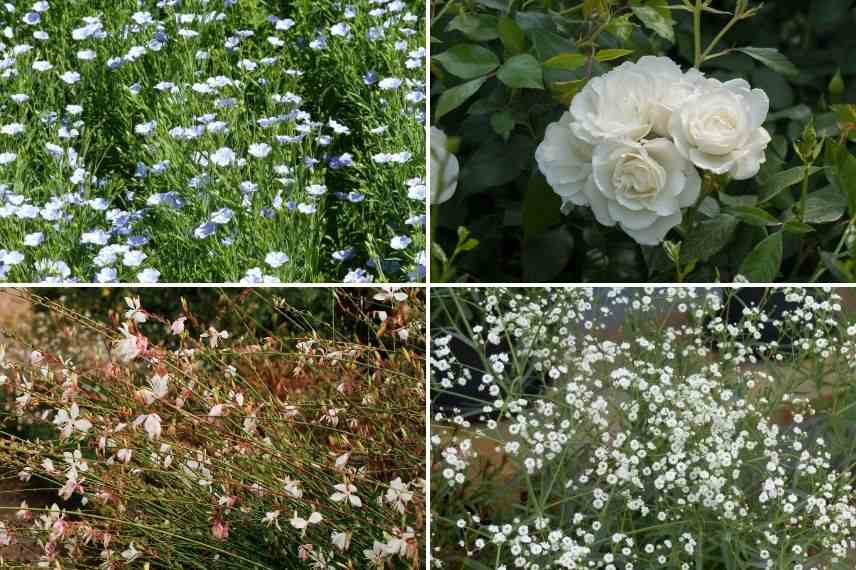
Linum grandiforum ‘Blue Dress’, Climbing rose ‘Fairy Snow’, Gaura ‘Snowstorm’ and Gypsophila ‘Festival White’
Discover other Linus - Ornamental Flax
View all →Available in 2 sizes
Available in 1 sizes
Available in 1 sizes
Available in 1 sizes
In a natural and wild garden
Flax is the champion for creating a rustic and natural atmosphere! With its light appearance and ease of cultivation, it also self-seeds! It’s a perfect plant to introduce into a garden that you want to be natural and wild. Pair, for example, Linum grandiflorum ‘Blue Dress’ with blue flowers and Nigella damascena ‘Persian Jewels Mix’ in blue, white, and pink. Accompany them with cosmos ‘Sonata White’ or cosmos ‘Sonata Light Pink’ with elegant and airy leaves.
You can also pair blue perennial flax with Echium russicum featuring large dark pink spikes that are very decorative, with meadow daisies, Euphorbia characias ‘Humpty Dumpty’ and lupins ‘Gallery Blue’. At the back of the border, you can add Muhlenbergia capillaris, a majestic grass that produces large, airy spikes in white and pale pink.

Linum perenne, Cosmos ‘Sonata Light Pink’, Nigella ‘Persian Jewels’ and Muhlenbergia capillaris
Read also
10 very easy perennials to sowIn a rockery or a dry garden
Flax is also the ideal young plant to install in a rockery or a low-water garden. Not demanding in terms of fertiliser and water, flax will thrive on its own. Pair for example the red flax – Linum grandiflorum ‘Rubrum’ with Love-in-a-Mist ‘Miss Jekyll Blue’, as well as Oriental poppies and Stipa pennata, poetic grasses.
You can also use other varieties of flax, such as Linum grandiflorum ‘Bright Eyes’ with white flowers and a purple centre or Linum grandiflorum ‘Charmer Salmon’ with salmon-pink flowers and a garnet centre. The display can also be varied in blue tones with Linum perenne and Linum narbonense ‘Heavenly Blue’.

Oriental poppy ‘Turkenlouis’, Linum grandiflorum ‘Rubrum’ (photo Sten Porse), Love-in-a-Mist ‘Miss Jekyll Blue’ (photo Wikipedia) and Stipa pennata
In a flowering meadow or of melliferous plants
If you love flowering meadows, you can recreate a miniature version in your garden by using flax. Combine, for example, the Linum narbonense ‘Heavenly Blue’, Linum perenne, and Linum grandiflorum ‘Blue Dress’ with yellow biennial evening primroses, common avens, and California poppies ‘Orange King’ to create a contrast of colours.
Flax is a melliferous plant that attracts pollinating insects. You can also create a small insect meadow in your garden and combine different varieties of flax with other melliferous plants, such as Buenos Aires vervains, ‘Butterfly Blue’ scabious, and mountain cornflowers or Centaurea montana ‘Violetta’, as well as red poppies – Papaver rhoeas.
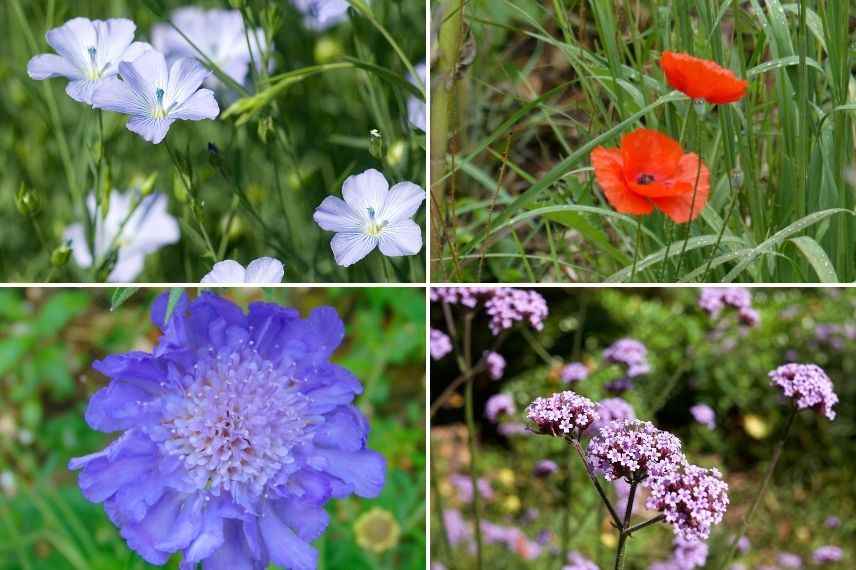
Linum perenne, Papaver rhoeas, Scabiosa columbaria ‘Butterfly Blue’ and Verbena bonariensis
In a romantic pot.
If you wish to bring a romantic and light atmosphere to your balcony, create a large flowering pot with eye-catching colours. Plant in a large pot some Linum perenne or Linum grandiflorum ‘Blue Dress’ and accompany it with one or two varieties of cosmos declinate in a palette of pink and white: the cosmos ‘Sensation Picotee’, cosmos ‘Sensation Radiance’ or cosmos ‘Sweet Sixteen’. Add some small grasses to enhance the lightness! This flowering pot should attract pollinating insects and possibly butterflies.

Cosmos ‘Sensation Radiance’ (photo nekonomania), Cosmos bipinnnatus ‘Sweet Sixteen’, Cosmos ‘Sensation Picotee’ (copyright Horticolor) and Linum perenne
For further reading
- To learn all about flax, check out our comprehensive guide dedicated to this lovely plant, as well as our collection of flax seeds!
- To avoid any failures, we recommend planting appropriately. Don’t hesitate to adopt our Plantfit web application!
- Subscribe!
- Contents
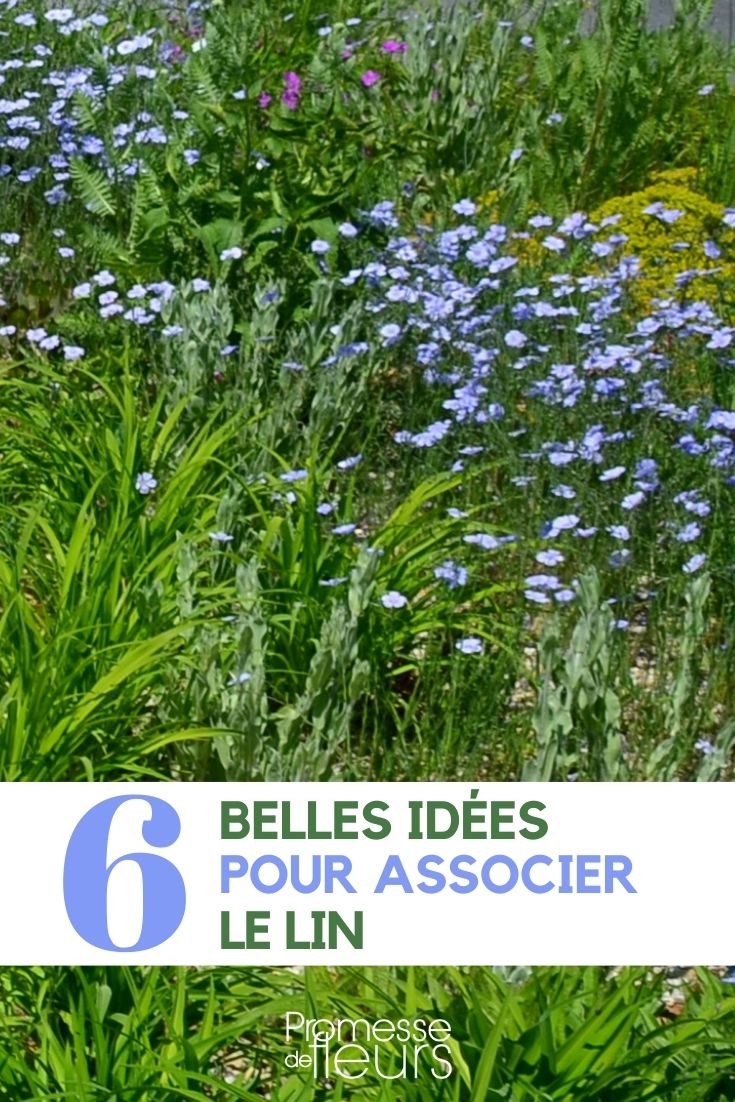
































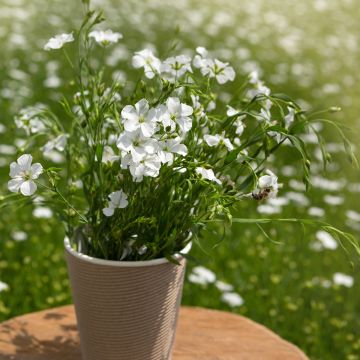

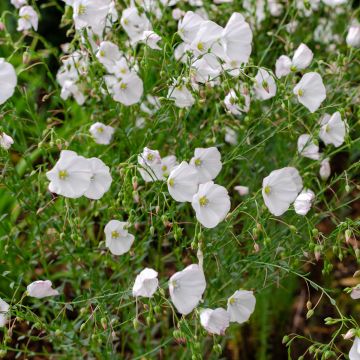
Comments